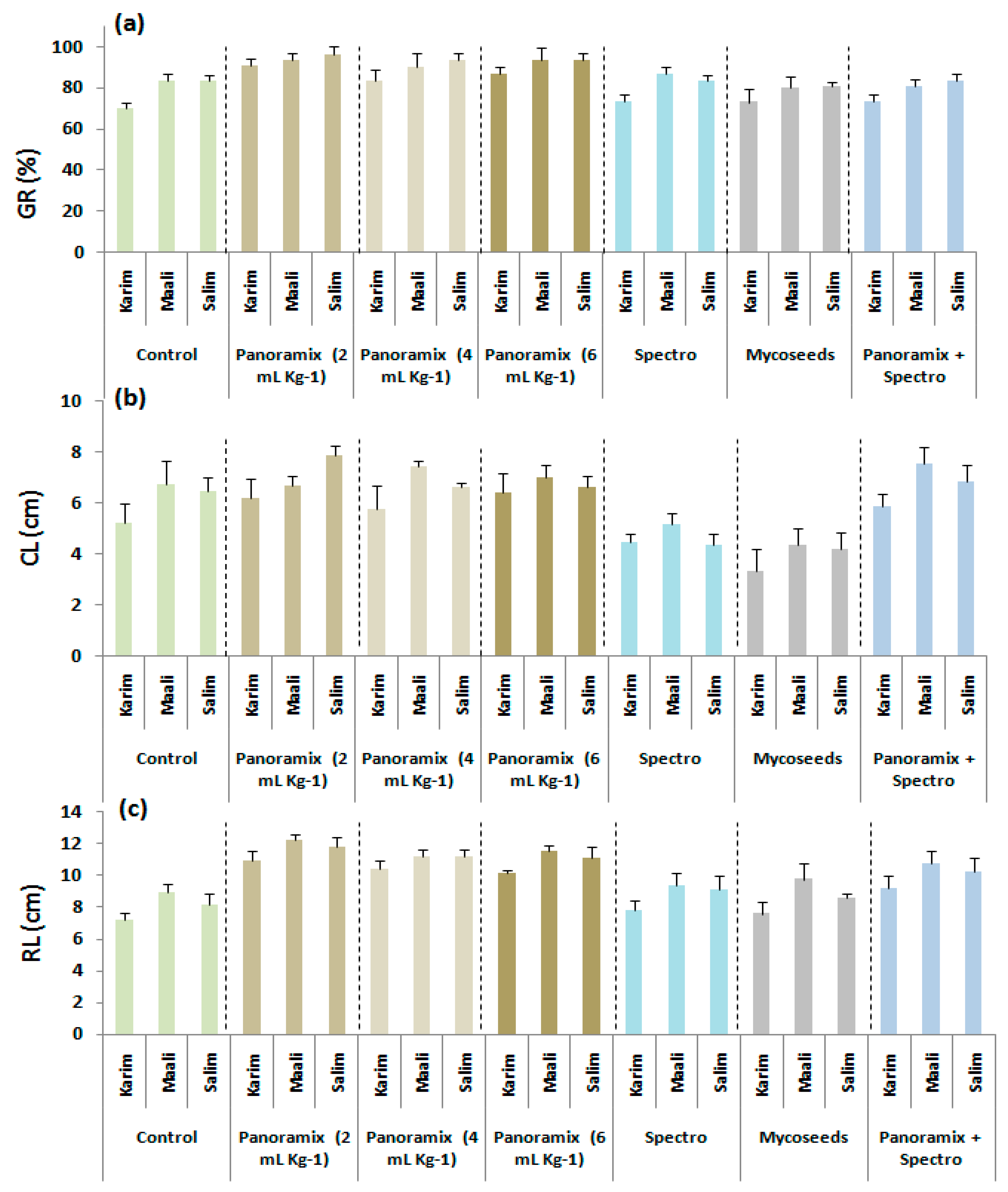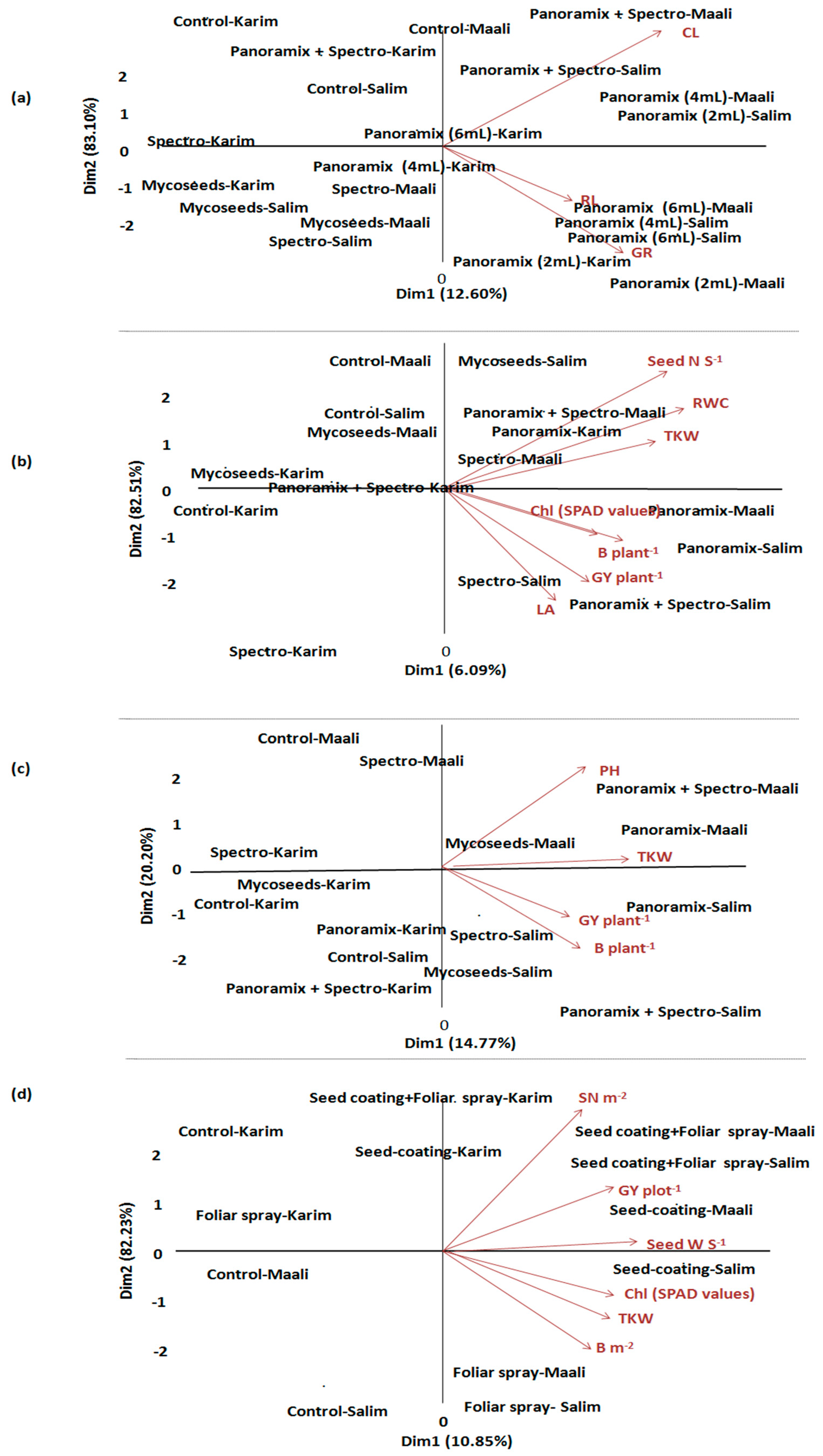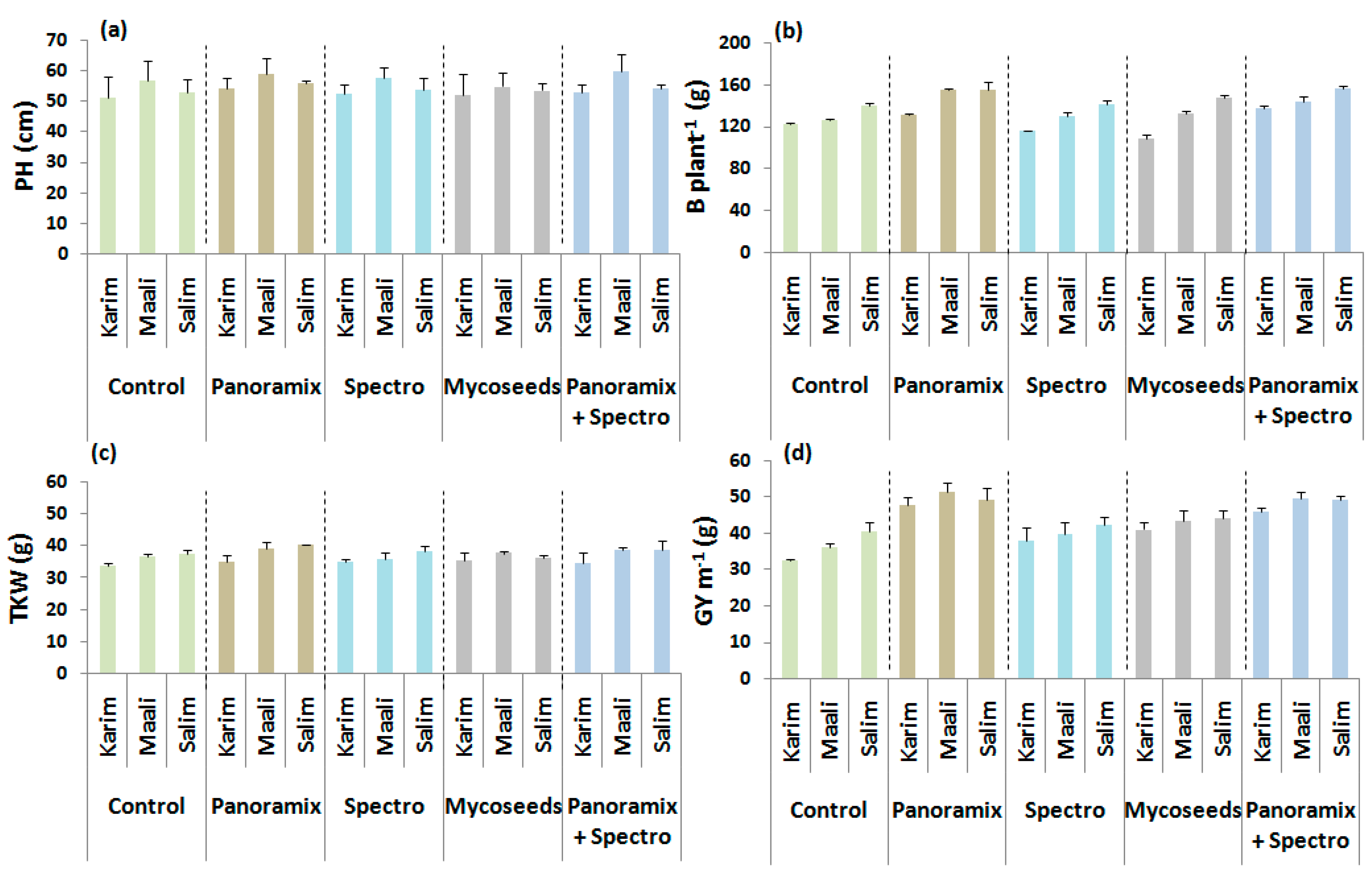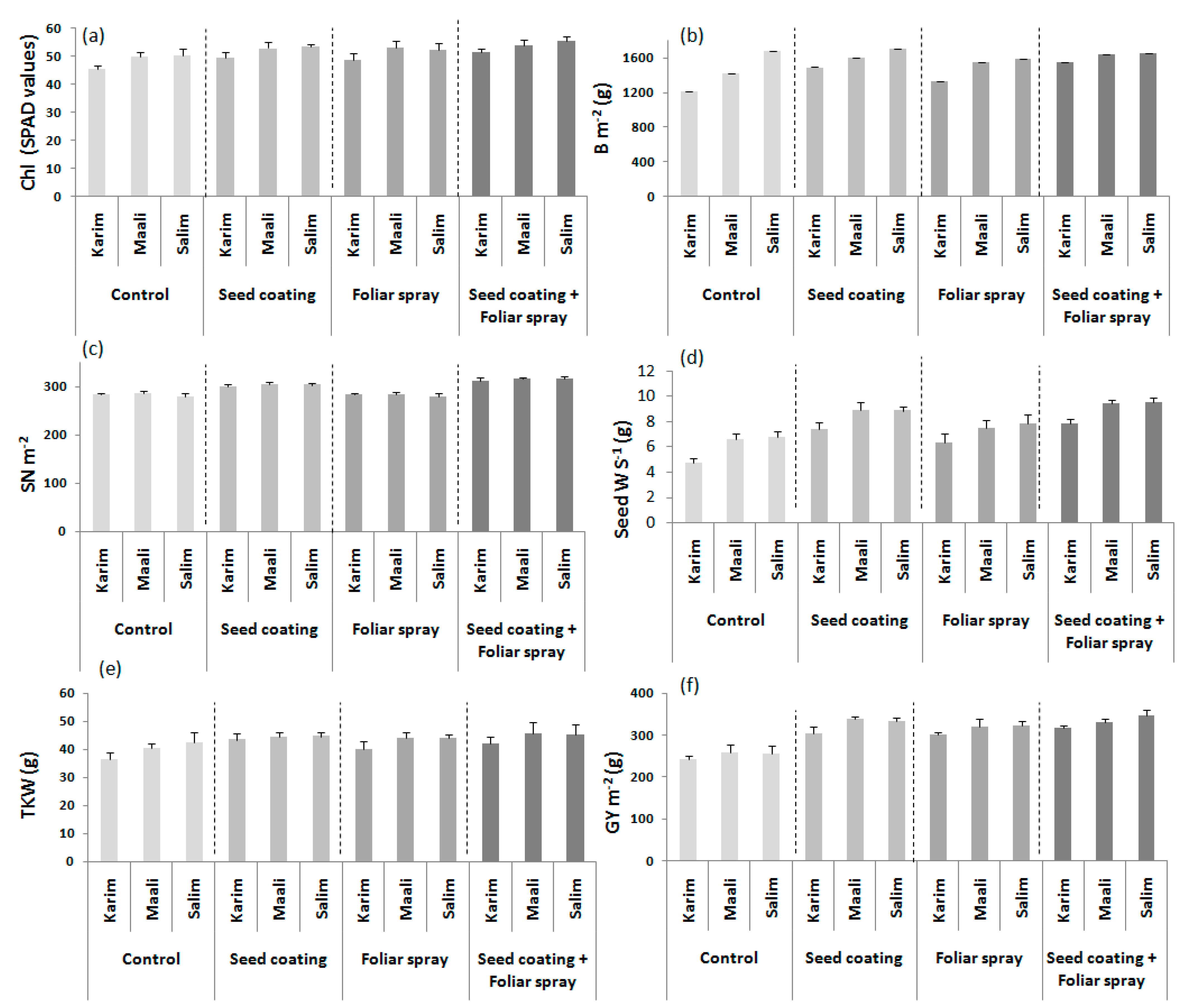Use of Biostimulants: Towards Sustainable Approach to Enhance Durum Wheat Performances
Abstract
1. Introduction
2. Results
2.1. Effects of Seed Coating Treatments on Germination Attributes
2.2. Effects of Seed Coating Treatments on Physiological and Agro-Morphological Attributes of Durum Wheat Cultivars Grown under Pot and Field Conditions
2.3. Effectiveness of Biostimulant Supply Methods
3. Discussion
3.1. Promising Effect of the Biostimulant ‘Panoramix’ on Durum Wheat Germination, Physiological, and Agro-Morphological Performances
3.2. Genotypic Variation against Seed and Foliar Treatments
3.3. Effectiveness of Biostimulant Depends on the Supply Methods
4. Materials and Methods
4.1. Vegetal Material
4.2. Seed Manipulation and Applied Treatments
4.3. Effectiveness of Biostimulant vs. Chemical Products Using Seed Coating Technique
4.3.1. Seed Germination Bioassay
4.3.2. Pot and Field Experiments under Semi-Arid Conditions
4.4. Effectiveness of Biostimulant Supply Methods under Field Conditions
4.5. Observations and Measurements
4.6. Statistical Data Analysis
5. Conclusions
Supplementary Materials
Author Contributions
Funding
Institutional Review Board Statement
Informed Consent Statement
Data Availability Statement
Acknowledgments
Conflicts of Interest
Abbreviations
| BS | biostimulant |
| PGPR | plant growth-promoting rhizobacteria |
| PGPF | plant growth-promoting fungi |
| AM fungi | arbuscular mycorrhizal fungi |
| GR | germination rate |
| CL | coleoptile length |
| RL | radicle length |
| RWC | relative water content |
| Chl | chlorophyll content |
| LA | leaf area |
| PH | plant height |
| B | Biomass |
| SN | spike number |
| SpkN S−1 | spikelet number per spike |
| Seed N S−1 | seed number per spike |
| Seed W S−1 | seed weight per spike |
| TKW | thousand kernel weight |
| GY | grain yield |
References
- Hellequin, E.; Monard, C.; Chorin, M.; Le bris, N.; Daburon, V.; Klarzynski, O.; Binet, F. Responses of active soil microorganisms facing to a soil biostimulant input compared to plant legacy effects. Sci. Rep. 2020, 10, 13727. [Google Scholar] [CrossRef]
- Yakhin, O.I.; Lubyanov, A.A.; Yakhin, I.A.; Brown, P.H. Biostimulants in plant science: A global perspective. Front. Plant Sci. 2017, 7, 2049. [Google Scholar] [CrossRef]
- Du Jardin, P. Plant biostimulants: Definition, concept, main categories and regulation. Sci. Hortic. 2015, 196, 3–14. [Google Scholar] [CrossRef]
- Kang, S.M.; Radhakrishnan, R.; Lee, K.E.; You, Y.H.; Ko, J.H.; Kim, J.H.; Lee, I.J. Mechanism of plant growth promotion elicited by Bacillus sp. LKE15 in oriental melon. Acta Agric. Scand. Sect. B Soil Plant Sci. 2015, 65, 637–647. [Google Scholar]
- Haas, D.; Defago, G. Biological control of soil-borne pathogens by fluorescent pseudomonads. Nat. Rev. Microbiol. 2005, 3, 307–319. [Google Scholar] [CrossRef] [PubMed]
- Beauregard, P.B.; Chai, Y.; Vlamakis, H.; Losick, R.; Kolter, R. Bacillus subtilis biofilm induction by plant polysaccharides. Proc. Natl. Acad. Sci. USA 2013, 110, E1621–E1630. [Google Scholar] [CrossRef]
- Harman, G.E.; Howell, C.R.; Viterbo, A.; Chet, I.; Lorito, M. Trichoderma species—Opportunistic, avirulent plant symbionts. Nat. Rev. Microbiol. 2004, 2, 43–56. [Google Scholar] [CrossRef]
- Mohiddin, F.A.; Khan, M.R.; Khan, S.M. Why Trichoderma is considered super hero (super fungus) against the evil parasites? Plant Pathol. J. 2010, 9, 92–102. [Google Scholar] [CrossRef]
- Poveda, J.; Abril-Urias, P.; Escobar, C. Biological control of plant-parasitic nematodes by filamentous fungi inducers of resistance: Trichoderma, mycorrhizal and endophytic fungi. Front. Microbiol. 2020, 11, 992. [Google Scholar] [CrossRef]
- Hermosa, R.; Viterbo, A.; Chet, I.; Monte, E. Plant-beneficial effects of Trichoderma and of its genes. Microbiology 2012, 158, 17–25. [Google Scholar] [CrossRef]
- López-Bucio, J.; Pelagio-Flores, R.; Herrera-Estrella, A. Trichoderma as biostimulant: Exploiting the multi level properties of a plant beneficial fungus. Sci. Hortic. 2015, 196, 109–123. [Google Scholar] [CrossRef]
- Fiorentino, N.; Ventorino, V.; Woo, S.L.; Pepe, O.; De Rosa, A.; Gioia, L.; Romano, I.; Lombardi, N.; Napolitano, M.; Colla, G.; et al. Trichoderma-based biostimulants modulate rhizosphere microbial populations and improve N uptake efficiency, yield, and nutritional quality of leafy vegetables. Front. Plant Sci. 2018, 9, 743. [Google Scholar] [CrossRef]
- Woo, S.L.; Ruocco, M.; Vinale, F.; Nigro, M.; Marra, R.; Lombardi, N.; Pascale, A.; Lanzuise, S.; Manganiello, G.; Lorito, M. Trichoderma-based products and their widespread use in agriculture. Open Mycol. J. 2014, 8, 71–126. [Google Scholar] [CrossRef]
- Smith, F.A.; Smith, S.E. What is the significance of the arbuscular mycorrhizal colonization of many economically important crop plants? Plant Soil 2011, 348, 63–79. [Google Scholar] [CrossRef]
- Jiang, Y.; Wang, W.; Xie, Q.; Liu, L.; Wang, D.; Zahang, X.; Yang, C.; Chen, X.; Tang, D.; Wang, E. Plants transfer lipids to sustain colonization by mutualistic mycorrhizal and parasitic fungi. Science 2017, 356, 1172. [Google Scholar] [CrossRef]
- Begum, N.; Qin, C.; Ahanger, M.A.; Raza, S.; Khan, M.I.; Ashraf, M.; Ahmed, N.; Zhang, L. Role of arbuscular mycorrhizal fungi in plant growth regulation: Implications in abiotic stress tolerance. Front. Plant Sci. 2019, 10, 1068. [Google Scholar] [CrossRef]
- Rocha, I.; Ma, Y.; Souza-Alonso, P.; Vosátka, M.; Freitas, H.; Oliveira, R.S. Seed coating: A tool for delivering beneficial microbes to agricultural crops. Front. Plant Sci. 2019, 10, 1357. [Google Scholar] [CrossRef]
- Kaufman, G. Seed coating: A tool for stand establishment; a stimulus to seed quality. HortTechnology 1991, 1, 98–102. [Google Scholar] [CrossRef]
- Afzal, I.; Javed, T.; Amirkhani, M.; Taylor, A.G. Modern seed technology: Seed coating delivery systems for enhancing seed and crop performance. Agriculture 2020, 10, 526. [Google Scholar] [CrossRef]
- Pedrini, S.; Merritt, D.J.; Stevens, J.; Dixon, K. Seed coating: Science or marketing spin? Trends Plant Sci. 2017, 22, 106–116. [Google Scholar] [CrossRef] [PubMed]
- Fernandez, V.; Brown, P.H. From plant surface to plant metabolism: The uncertain fate of foliar-applied nutrients. Front. Plant Sci. 2013, 4, 289. [Google Scholar] [CrossRef]
- Díaz-Leguizamón, J.J.; Chingaté-Cruz, O.F.; Sánchez-Reinoso, A.D.; Restrepo-Díaz, H. The effect of foliar applications of a bio-stimulant derived from algae extract on the physiological behavior of lulo seedlings (Solanum quitoense cv. Septentrionale). Cien. Inv. Agr. 2016, 43, 25–37. [Google Scholar] [CrossRef][Green Version]
- Ganugi, P.; Masoni, A.; Pietramellara, G.; Benedettelli, S. A review of studies from the last twenty years on plant—Arbuscular mycorrhizal fungi associations and their uses for wheat crops. Agronomy 2019, 9, 840. [Google Scholar] [CrossRef]
- Kumar, A.; Singh, V.K.; Tripathi, V.; Singh, P.P.; Singh, A.K. Plant Growth-Promoting Rhizobacteria (PGPR): Perspective in agriculture under biotic and abiotic Stress. In New and Future Developments in Microbial Biotechnology and Bioengineering: Crop Improvement through Microbial Biotechnology, 1st ed.; Prasad, R., Gill, S.S., Tuteja, N., Eds.; Elsevier: Hoboken, NJ, USA, 2018; pp. 333–342. [Google Scholar]
- Rouphael, Y.; Cardarelli, M.; Bonini, P.; Colla, G. Synergistic action of a microbial-based biostimulant and a plant derived-protein hydrolysate enhances lettuce tolerance to alkalinity and salinity. Front. Plant Sci. 2017, 8, 131. [Google Scholar] [CrossRef] [PubMed]
- Zin, N.A.; Badaluddin, N.A. Biological functions of Trichoderma spp. for agriculture applications. Ann. Agric. Sci. 2020, 65, 168–178. [Google Scholar] [CrossRef]
- Saa, S.; Olivos-Del Rio, A.; Castro, S.; Brown, P.H. Foliar application of microbial and plant based biostimulants increases growth and potassium uptake in almond (Prunus dulcis [Mill.] D. A. Webb). Front. Plant Sci. 2015, 6, 1–9. [Google Scholar] [CrossRef]
- Sabir, A.; Yazar, K.; Sabir, F.; Kara, Z.; Yazici, M.A.; Goksu, N. Vine growth, yield, berry quality attributes and leaf nutrient content of grapevines as influenced by seaweed extract (Ascophyllum nodosum) and nanosize fertilizer pulverizations. Sci. Hortic. 2014, 175, 1–8. [Google Scholar] [CrossRef]
- Sadok, W.; Schoppach, R.; Ghanem, M.E.; Zucca, C.; Sinclair, T.R. Wheat drought-tolerance to enhance food security in Tunisia, birthplace of the Arab Spring. Eur. J. Agron. 2019, 107, 1–9. [Google Scholar] [CrossRef]
- Chahed, Y. Tunisia Grain, Grain and Feed Annual; Grain Report; USDA Foreign Agriculture Service: Washington, DC, USA, 2009.
- Kthiri, Z.; Ben Jabeur, M.; Machraoui, M.; Gargouri, S.; Hiba, K.; Hamada, W. Coating seeds with Trichoderma strains promotes plant growth and enhance the systemic resistance against Fusarium crown rot in durum wheat. Egypt. J. Biol. Pest Control 2020, 30, 139. [Google Scholar] [CrossRef]
- Harman, G.E. Myths and dogmas of biocontrol changes in perceptions derived from research on Trichoderma harzinum T-22. Plant Dis. 2000, 84, 377–393. [Google Scholar] [CrossRef] [PubMed]
- Poštić, D.; Štrbanović, R.; Tabaković, M.; Popović, T.; Cirić, A.; Banjac, N.; Trkulja, N.; Stanisavljević, R. Germination and the initial seedling growth of lettuce, celeriac and wheat cultivars after micronutrient and a biological application pre-sowing seed treatment. Plants 2021, 10, 1913. [Google Scholar] [CrossRef] [PubMed]
- Li, Y.-J.; Hu, Q.-P. Studying of the promotion mechanism of Bacillus subtilis QM3 on wheat seed germination based on β-amylase. Open Life Sci. 2020, 15, 553–560. [Google Scholar] [CrossRef] [PubMed]
- Hu, Q.P.; Liu, R.X.; Liu, J.X. Effects of Bacillus subtilis QM3 on germination and antioxidant enzymes activities of wheat seeds under salt stress. Open Access Libr. 2019, 6, e5218. [Google Scholar] [CrossRef]
- Alvarado-Sanabria, O.H.; Álvarez-Herrera, J.G. Effect of indole-3-butyric acid and Trichoderma harzianum Rifai on asexual cape gooseberry propagation (Physalis peruviana L.). Agron. Colomb. 2014, 32, 326–333. [Google Scholar] [CrossRef]
- Siemering, G.; Ruark, M.; Geven, A. The value of Trichoderma for Crop Production; University of Wisconsin-Extension, Cooperative Extension: Madison, WI, USA, 2016. [Google Scholar]
- Bader, A.N.; Salerno, G.L.; Covacevich, F.; Consolo, V.F. Native Trichoderma harzianum strains from Argentina produce indole-3 acetic acid and phosphorus solubilization, promote growth and control wilt disease on tomato (Solanum lycopersicum L.). J. King Saud. Univ. Sci. 2020, 32, 867–873. [Google Scholar] [CrossRef]
- Cai, F.; Yu, G.; Wang, P.; Wei, Z.; Fu, L.; Shen, Q.; Chen, W. Harzianolide, a novel plant growth regulator and systemic resistance elicitor from Trichoderma harzianum. Plant Physiol. Biochem. 2013, 73, 106–113. [Google Scholar] [CrossRef]
- Vinale, F.; Nigro, M.; Sivasithamparam, K.; Flematti, G.; Ghisalberti, E.; Ruocco, M.; Varlese, R.; Marra, R.; Lanzuise, S.; Eid, A.; et al. Harzianic acid: A novel siderophore from Trichoderma harzianum. FEMS Microbiol. Lett. 2013, 347, 123–129. [Google Scholar] [CrossRef]
- Radhakrishnan, R.; Hashem, A.; Abdallah, E.F. Bacillus: A biological tool for crop improvement through bio-molecular changes in adverse environments. Front. Physiol. 2017, 8, 667. [Google Scholar] [CrossRef]
- Ahmed, A.; Hasnain, S. Auxin-producing Bacillus sp.: Auxin quantification and effect on the growth of Solanum tuberosum. Pure Appl. Chem. 2010, 82, 313–319. [Google Scholar] [CrossRef]
- Arkhipova, T.N.; Veselov, S.U.; Melentiev, A.I.; Martynenko, E.V.; Kudoyarova, G.R. Ability of bacterium Bacillus subtilis to produce cytokinins and to influence the growth and endogenous hormone content of lettuce plants. Plant Soil 2005, 272, 201–209. [Google Scholar] [CrossRef]
- Pourbabaee, A.A.; Bahmani, E.; Alikhani, H.A.; Emami, S. Promotion of wheat growth under salt stress by halotolerant bacteria containing ACC deaminase. J. Agric. Sci. Technol. 2016, 18, 855–864. [Google Scholar]
- Radhakrishnan, R.; Lee, I.J. Gibberellins producing Bacillus methylotrophicus KE2 supports plant growth and enhances nutritional metabolites and food values of lettuce. Plant Physiol. Biochem. 2016, 109, 181–189. [Google Scholar] [CrossRef]
- Jha, C.K.; Saraf, M. Plant Growth Promoting Rhizobacteria (PGPR): A review. E3 J. Agric. Res. Dev. 2015, 5, 0108–0119. [Google Scholar]
- Vacheron, J.; Desbrosses, G.; Bouffaud, M.; Touraine, B.; Moenne-Loccoz, Y.; Muller, D.; Legendre, L.; Wisniewski-Dye, F.; Prigent-Combaret, C. Plant Growth-Promoting Rhizobacteria and root system functioning. Front. Plant Sci. 2013, 4, 356. [Google Scholar] [CrossRef]
- Xu, M.; Sheng, J.; Chen, L.; Men, Y.; Gan, L.; Guo, S.; Shen, L. Bacterial community compositions of tomato (Lycopersicum esculentum Mill.) seeds and plant growth promoting activity of ACC deaminase producing Bacillus subtilis (HYT-12-1) on tomato seedlings. World J. Microbiol. Biotechnol. 2014, 30, 835–845. [Google Scholar] [CrossRef] [PubMed]
- Kuan, K.B.; Othman, R.; Rahim, K.A.; Shamsuddin, Z.H. Plant Growth-Promoting Rhizobacteria inoculation to enhance vegetative growth, nitrogen fixation and nitrogen remobilisation of maize under greenhouse conditions. PLoS ONE 2016, 11, e0152478. [Google Scholar] [CrossRef] [PubMed]
- Piotrowska, M.; Kusewicz, D. Soil microflora. In Technical Microbiology; Microorganisms and Their Environment; Libudzisz, Z., Kowal, K., Eds.; Scientific Publisher PWN: Warszawa, Poland, 2007; pp. 195–200. [Google Scholar]
- Ding, Y.; Wang, J.; Liu, Y.; Chen, S. Isolation and identification of nitrogen-fixing bacilli from plant rhizospheres in Beijing region. J. Appl. Microbiol. 2005, 99, 1271–1281. [Google Scholar] [CrossRef]
- Kang, S.M.; Radhakrishnan, R.; You, Y.H.; Joo, G.J.; Lee, I.J.; Lee, K.E.; Kim, J.H. Phosphate solubilizing Bacillus megaterium mj1212 regulates endogenous plant carbohydrates and amino acids contents to promote mustard plant growth. Indian J. Microbiol. 2014, 54, 427–433. [Google Scholar] [CrossRef]
- Nadeem, S.M.; Shaharoona, B.; Arshad, M.; Crowley, D.E. Population density and functional diversity of plant growth promoting rhizobacteria associated with avocado trees in saline soils. Agric. Ecosyst. Environ. Appl. Soil Ecol. 2012, 62, 147–154. [Google Scholar] [CrossRef]
- Huang, X.F.; Jacqueline, M.; Chaparro, K.F.; Zhang, R.; Shen, Q.; Vivanco, J.M. Rhizosphere interactions: Root exudates, microbes, and microbial communities. Botany 2014, 92, 267–275. [Google Scholar] [CrossRef]
- Sood, M.; Kapoor, D.; Kumar, V.; Sheteiwy, M.S.; Ramakrishnan, M.; Landi, M.; Araniti, F.; Sharma, A. Trichoderma: The “secrets” of a multitalented biocontrol agent. Plants 2020, 9, 762. [Google Scholar] [CrossRef]
- Carvalhais, L.C.; Dennis, P.G.; Badri, D.V.; Kidd, B.N.; Vivanco, J.M.; Schenk, P.M. Linking jasmonic acid signaling, root exudates, and rhizosphere microbiomes. Mol. Plant-Microbe Interact. 2015, 28, 1049–1058. [Google Scholar] [CrossRef]
- Al-Karaki, G.N.; Al-Raddad, A.; Clark, R.B. Water stress and mycorrhizal isolate effects on growth and nutrient acquisition of wheat. J. Plant Nutr. 1998, 21, 891–902. [Google Scholar] [CrossRef]
- Zhang, S.; Lehmann, A.; Zheng, W.; You, Z.; Rillig, M.C. Arbuscular mycorrhizal fungi increase grain yields: A meta-analysis. New Phytol. 2019, 222, 543–555. [Google Scholar] [CrossRef]
- Davies, F.T., Jr.; Potter, J.R.; Linderman, R.G. Mycorrhiza and repeated drought exposure affect drought resistance and extraradical hyphae development on pepper plants independent of plant size and nutrient content. J. Plant Physiol. 1992, 139, 289–294. [Google Scholar] [CrossRef]
- Jayne, B.; Quigley, M. Influence of arbuscular mycorrhiza on growth and reproductive response of plants under water deficit: A meta analysis. Mycorrhiza 2014, 24, 109–119. [Google Scholar] [CrossRef]
- Adesemoye, A.; Torbert, H.; Kloepper, J. Plant Growth-Promoting Rhizobacteria allow reduced application rates of chemical fertilizers. Microb. Ecol. 2009, 58, 921–929. [Google Scholar] [CrossRef]
- Norrie, J.; Keathley, J.P. Benefits of Ascophyllum nodosum marine plant extract applications to ‘Thompson seedless’ grape production. Acta Hortic. 2006, 71, 22–28. [Google Scholar] [CrossRef]
- Gajc-Wolska, J.; Spizewski, T.; Grabowska, A. The effect of seaweed extracts on the yield and quality parameters of Broccoli (Brassica oleracea var. cymosa L.) in open field production. Acta Hortic. 2013, 1009, 83–89. [Google Scholar] [CrossRef]
- Sharma, H.S.S.; Fleming, C.; Selby, C.; Rao, J.R.; Martin, T. Plant biostimulants: A review on the processing of macroalgae and use of extracts for crop management to reduce abiotic and biotic stresses. J. Appl. Phycol. 2014, 26, 465–490. [Google Scholar] [CrossRef]
- Amutha, M. Establishment of Beauveria bassiana (Balsamo) vuillemin as an endophyte in cotton. Int. J. Curr. Microbiol. App. Sci. 2017, 6, 2506–2513. [Google Scholar] [CrossRef][Green Version]
- Tavares, L.C.; Rufino, C.D.A.; Brunes, A.P.; Friedrich, F.F.; Barros, A.C.S.A.; Villela, F.A. Physiological performance of wheat seeds coated with micronutrients. J. Seed Sci. 2013, 35, 28–34. [Google Scholar] [CrossRef]
- Xue, A.G.; Guo, W.; Chen, Y.; Siddiqui, I.; Marchand, G.; Liu, J.; Ren, C. Effect of seed treatment with novel strains of Trichoderma spp. on establishment and yield of spring wheat. J. Crop Prot. 2017, 96, 97–102. [Google Scholar] [CrossRef]
- USDA. Soil Classification: A Comprehensives System (Prepared by) Soil Survey Staff; Government Printing Office: Washington, DC, USA, 2013. [Google Scholar]
- Zadoks, J.C.; Chang, T.T.; Konzak, C.F. A decimal code for the growth stages of cereals. Weed Res. 1974, 14, 415–421. [Google Scholar] [CrossRef]
- Clark, J.M.; Mac-Caig, T.N. Excised leaf water relation capability as an indicator of drought resistance of Triticum genotypes. Can. J. Plant Sci. 1982, 62, 571–576. [Google Scholar] [CrossRef]





| Sources of Variation | df 1 | GR (%) | CL (cm) | RL (cm) |
|---|---|---|---|---|
| Treatment (T) | 6 | 5.63 *** 2 | 25.13 *** | 14.66 *** |
| Cultivar (C) | 2 | 3.06 * | 3.820 * | 5.66 * |
| T × C interaction | 12 | 1.26 ns | 1.69 ns | 2.24 * |
| Treatments | ||||
| Control | 79.11b 3 | 6.13a | 8.10c | |
| Panoramix (2 mL kg−1) | 93.33a (15%) | 6.91a (11%) | 11.64a (30%) | |
| Panoramix (4 mL kg−1) | 88.88ab (11%) | 6.59a (7%) | 10.92ab (26%) | |
| Panoramix (6 mL kg−1) | 91.22a (13%) | 6.67a (8%) | 10.93ab (26%) | |
| Spectro | 81.11b (2%) | 4.64b (24%) | 8.76c (7%) | |
| Mycoseeds | 77.89b (−1%) | 3.97c (35%) | 8.62c (6%) | |
| Panoramix (4 mL kg−1) + Spectro | 79.09b (0.1%) | 6.76a (9%) | 10.06b (19%) | |
| Cultivars | ||||
| Karim | 78.66b | 6.20b | 9.04c | |
| Maali | 86.84a | 7.48a | 12.28a | |
| Salim | 87.61a | 7.15a | 11.70b | |
| Sources of Variation | df 1 | RWC (%) | Chl (SPAD Values) | LA (cm2) | PH (cm) | B Plant−1 (g) | Seed N S−1 | TKW (g) | GY Plant−1 (g) |
|---|---|---|---|---|---|---|---|---|---|
| Treatment (T) | 4 | 3.45 * 2 | 3.19 * | 21.69 *** | 1.13 ns | 8.93 * | 3.22 * | 3.21 * | 4.93 ** |
| Cultivar (C) | 2 | 3.52 * | 3.78 * | 6.28 * | 3.57 ns | 7.46 * | 6.11 * | 3.31 * | 2.83 * |
| T × C interaction | 8 | 0.62 ns | 2.18 * | 2.79 * | 3.84 ** | 2.03 * | 2.48 * | 1.48 ns | 1.07 ns |
| Treatments | |||||||||
| Control | 55.81c 3 | 47.74b | 18.48b | 55.22a | 51.42c | 13.89b | 33.44c | 14.64d | |
| Panoramix (2 mL kg−1) | 74.95a (25%) | 54.79a (13%) | 21.51a (14%) | 54.56a (−1%) | 73.36a (30%) | 16.33a (15%) | 41.19a (19%) | 19.87a (26%) | |
| Spectro | 56.99c (2%) | 51.08ab (6%) | 20.87a (11%) | 52.00a (−6%) | 54.89c (6%) | 14.11b (2%) | 35.77b (6%) | 17.38ab (16%) | |
| Mycoseeds | 58.62ab (5%) | 47.90b (0.5%) | 19.46ab (5%) | 55.00a (−0.4%) | 54.80c (6%) | 14.33b (3%) | 37.72ab (11%) | 16.13cd (9%) | |
| Panoramix (2 mL kg−1) + Spectro | 63.85ab (13%) | 48.86b (2%) | 20.90a (12%) | 52.11a (6%) | 65.88b (22%) | 15.22ab (9%) | 39.80a (16%) | 18.53ab (21%) | |
| Cultivars | |||||||||
| Karim | 54.33b | 46.07b | 19.42a | 56.33a | 52.05c | 14.99b | 33.30b | 14.99b | |
| Maali | 66.18a | 52.77a | 21.85a | 55.93a | 67.00a | 18.88a | 38.74a | 18.88a | |
| Salim | 65.62a | 51.38a | 20.27ab | 55.07a | 61.15b | 18.07a | 39.30a | 18.07a | |
| Sources of Variation | df 1 | PH (cm) | B Plant−1 (g) | Seed N S−1 | TKW (g) | GY m−1 (g) |
|---|---|---|---|---|---|---|
| Treatment (T) | 4 | 2.49 * 2 | 32.21 *** | 2.60 ns | 20.49 *** | 10.89 *** |
| Cultivar (C) | 2 | 0.39 ns | 6.10 ** | 2.37 * | 0.37 ns | 4.30 * |
| T × C interaction | 8 | 0.44 ns | 9.66 *** | 8.92 *** | 8.04 *** | 4.46 *** |
| Treatments | ||||||
| Control | 52.67c 3 | 129.16a | 20.06a | 36.05b | 36.41c | |
| Panoramix (2 mL kg−1) | 55.44a (5%) | 147.59a (12%) | 23.28a (14%) | 38.17a (5%) | 49.58a (27%) | |
| Spectro | 54.78ab (4%) | 129.09a (0.1%) | 19.94a (1%) | 36.36b (1%) | 40.08bc (9%) | |
| Mycoseeds | 52.56c (0.2%) | 129.81a (0.5%) | 22.72a (12%) | 36.39b (1%) | 43.02b (15%) | |
| Panoramix (2 mL kg−1) + Spectro | 55.67a (5%) | 145.96a (11%) | 20.89a (4%) | 37.38ab (4%) | 48.31a (25%) | |
| Cultivars | ||||||
| Karim | 52.67a | 121.18c | 21.80ab | 35.12a | 40.30b | |
| Maali | 54.60a | 136.52b | 22.67a | 37.66a | 43.72ab | |
| Salim | 54.20a | 148.08a | 19.67b | 38.04a | 45.03a | |
| Sources of Variation | df 1 | Chl (SPAD Values) | PH (cm) | B m−2 (g) | SN m−2 | Spk N S−1 | Seed N S−1 | Seed W S−1 (g) | TKW (g) | GY m−2 (g) |
|---|---|---|---|---|---|---|---|---|---|---|
| Treatment | 3 | 6.96 *** 2 | 0.98 ns | 8.87 *** | 111.14 ** | 0.25 ns | 0.55 ns | 5.12 ** | 1.34 * | 73.59 *** |
| Cultivar | 2 | 0.49 ns | 3.08 ns | 5.61 *** | 1.42 ns | 3.77 * | 0.46 ns | 1.40 ** | 0.53 * | 0.08 ** |
| T × C interaction | 6 | 0.42 ns | 1.48 ns | 10.40 *** | 0.68 ns | 1.37 ns | 1.45 ns | 1.76 ns | 1.06 ns | 2.92 * |
| Treatments | ||||||||||
| Control | 48.58a 3 | 66.19a | 1430b | 283.00c | 12.52b | 18.48a | 6.03b | 39.83bc | 252 310b | |
| Seed coating | 51.96ab (6%) | 64.00a (3%) | 1600a (11%) | 302.41b (6%) | 15.62a (20%) | 18.48a (0%) | 8.38a (28%) | 44.20ab (10%) | 325 380a (22%) | |
| Foliar spray | 51.44ab (6%) | 66.44a (0.4%) | 1490b (4%) | 282.15c (0.3%) | 13.75b (9%) | 17.93a (3%) | 7.56ab (20%) | 42.67bc (7%) | 314 780a (20%) | |
| Seed coating + Foliar spray | 53.62a (9%) | 64.11a (3%) | 1610a (11%) | 315.19a (10%) | 15.47a (19%) | 16.59a (10%) | 8.94a (32%) | 44.40a (10%) | 331 920a (24%) | |
| Cultivars | ||||||||||
| Karim | 48.83b | 66.39a | 1400b | 294.78b | 12.77b | 17.61b | 6.57b | 40.61b | 291 690b | |
| Maali | 52.44a | 66.31a | 1550ab | 297.50a | 15.07a | 17.33b | 8.09a | 43.66a | 312 030a | |
| Salim | 52.93a | 62.86a | 1660a | 294.78b | 15.17a | 18.67a | 8.26a | 44.06a | 314 570a | |
| Products | Composition | Quantities |
|---|---|---|
| Panoramix | Mix of Bacillus spp. (2 × 107 CFU mL−1), Trichoderma spp. (>1 × 107 CFU mL−1), endomycorrhiza (>10 propagules mL−1) and additives | 2 mL per kg of seeds 4 mL per kg of seeds 6 mL per kg of seeds |
| Mycoseeds FS 60 | 60 g L−1 Tebuconazole | 0.5 mL of product + 5 mL of water per kg of seeds |
| Spectro extreme 115 FS | 92 g L−1 Difenoconazole + 23 g L−1 Métalaxyl-M | 0.65 mL of product + 5 mL of water per kg of seeds |
Publisher’s Note: MDPI stays neutral with regard to jurisdictional claims in published maps and institutional affiliations. |
© 2021 by the authors. Licensee MDPI, Basel, Switzerland. This article is an open access article distributed under the terms and conditions of the Creative Commons Attribution (CC BY) license (https://creativecommons.org/licenses/by/4.0/).
Share and Cite
Ayed, S.; Bouhaouel, I.; Jebari, H.; Hamada, W. Use of Biostimulants: Towards Sustainable Approach to Enhance Durum Wheat Performances. Plants 2022, 11, 133. https://doi.org/10.3390/plants11010133
Ayed S, Bouhaouel I, Jebari H, Hamada W. Use of Biostimulants: Towards Sustainable Approach to Enhance Durum Wheat Performances. Plants. 2022; 11(1):133. https://doi.org/10.3390/plants11010133
Chicago/Turabian StyleAyed, Sourour, Imen Bouhaouel, Hayet Jebari, and Walid Hamada. 2022. "Use of Biostimulants: Towards Sustainable Approach to Enhance Durum Wheat Performances" Plants 11, no. 1: 133. https://doi.org/10.3390/plants11010133
APA StyleAyed, S., Bouhaouel, I., Jebari, H., & Hamada, W. (2022). Use of Biostimulants: Towards Sustainable Approach to Enhance Durum Wheat Performances. Plants, 11(1), 133. https://doi.org/10.3390/plants11010133






